Abstract
The conditions for adopting innovations in the virtual environment vary from regional to some that act globally, the importance of each differing relatively depending on the specific socio-economic context. Educational systems around the world are changing rapidly to keep pace with new technologies and with the increasingly dynamic relationship between technology and education. The constant and unprecedented evolution of technology requires new skills, behaviours and attitudes. The adoption of new technologies is largely dependent on the teachers’, students’ and pupils’ degree of adaptation to new technologies. Being digital natives, students and pupils have constant interactions with technology developing their skills in the field of critical analysis and metacognition. Teachers need to be creative and innovative in designing their instructional strategies to provide an interactive and meaningful learning experience for their pupils and students. Open education promotes the harmonious blending of the oriented content approach through using open educational resources, which focus on teaching materials, with the oriented practice approach through open educational practices that encourage collaboration between students and pedagogical coordinators, students and teachers as mentors, pupils and teachers, pupils and students as practitioners for the creation and exchange of knowledge. Pedagogy focuses on teaching-learning-evaluation practices and curriculum knowledge and requires teachers to apply technologies in order to develop pupils and students' skills and creativity, which involves planning strategies to direct training in an intensive technological environment.
Keywords: Diffusion of technology, education, pedagogical practice
Introduction
In education, globally, technology is a major agent of change creating challenges and opportunities. Much of the change in education is due to new technologies. The digitalization of education through new products and processes offers important advantages and benefits. Creating ideas and accumulating knowledge are found in innovative technology-based products. Starting from the definition of technology diffusion as the process by which new technology is communicated over time between participants in a social system (Rogers, 2003), we also identify in education the four main elements that influence the spread of new ideas: innovation itself, channels of communication, time and social system.
Adopters of educational technologies are no longer satisfied only with the use of open educational resources but seek to receive value, utility and satisfaction, to be designed and achieved in accordance with their expectations and requirements. Holotescu and Gosseck (2020) adapts Rogers' theory on the innovation diffusion in the context of educational technologies in terms of open educational practices and types of open educational resources adopters. The authors view open educational practices as an ensemble created around the adoption, use and management of open educational resources.
Glava (2020) sustains the idea of education based on technology according to which it should not be necessary for the students to attend school constantly in order to participate at teaching activities but for the teachers to reach the pupils and students through the computer and the Internet, and to adapt the courses and activities to these conditions.
The adoption of educational technologies
If Ievenberg et al. (2018) affirm that “technology enabled the ability to search, but did not dictate the search” (p. 75), Huang et al. (2019) considered that educational technology can be regarded as a system composed from a variety of components and relationships in order to improve user’s performance. In the education system, users are students, teachers, parents, support personnel, administrators, and policy makers. In Figure 1 below, 7 essential items for using educational technology highlighted by the scientific literature are represented.
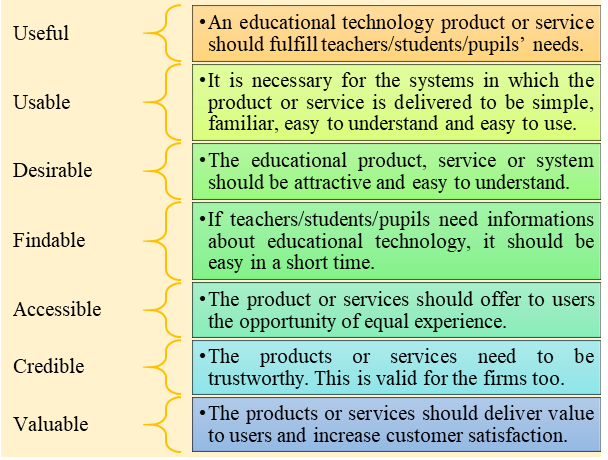
Rogers' theory of the innovation decision-making process is about the diffusion of innovation as a process that takes place over time and occurs through five stages as seen in Figure 2 below (Lobonţiu et al., 2008).

The adoption of innovation in education is a process through which a teacher, student or pupil, before making decisions, transmits awareness of innovation, forms an attitude towards innovation, makes the decision to adopt or reject it, implements a new idea, and confirms this decision (Lobonţiu et al., 2008) as seen in Figure 3 below.

A new technology needs time to gain importance in education. Thus, for a start, it must be introduced into open educational practices and then gradually adopted by more users. Mukoyama (2003) considers that diffusion is as important as innovation, arguing that new technologies cannot have an impact until they are widespread. As an example, this is the case with the new open educational resources, which are initially difficult to use. This feature leads to a well-known empirical event: a high level of competence is required in the initial stage of technology diffusion. To investigate the endogenous process of technology diffusion, Mukoyama (2003) raises the following question: "if a new technology requires skill, how is it possible that it will eventually be adopted by less-skilled users?" (p. 3). And there is the answer that as they mature, educational technologies become easier to use and can be handled more easily, becoming more reliable.
Problem Statement
Cucoș (2020) states that knowledge is no longer an “ideational baggage to be understood, but an edifice to be built by probing, exploring, inventing, collaborating”, as seen in Figure 4 below. The same author believes that, by adopting new educational technologies, teachers and students have multiple opportunities for creation, individualization, communication and cooperation.

Israte (2020) states that the spread of information and communication technologies among teachers and students involve a long, multi-stage process, and regard the implementation of new technologies as one of the most effective ways to achieve positive results. Cydis (2015) considers the development of teachers’ beliefs in the integration of technology as an indispensable resource for creating their courses to be important for the formation of the pupils and students’ competencies. The same author sees technology as a need for teachers, an essential part of a curriculum that integrates a constructivist approach to performance-based learning for students in order to bring a real benefit to learning. Technology adoption in education requires additional efforts for teachers and students, such as:
- adaptation of teaching tools using new technologies;
- need of being trained to use technologies;
- endowment with equipment for using technologies.
Research Questions
The research question is as follows: Is the technology adoption through the acceptance and willingness of teachers and students to use educational technologies a prerequisite for increasing the value of open educational practices?
Starting from the approach of technology diffusion in education in order to identify the impact of digital technologies on open educational practices, the author proceeds to investigate the influence of digital technologies on the decision to adopt a new technology, and the attitude of educational agents towards adopting new technologies.
Purpose of the Study
The study approaches the attitude of teachers and students towards technologies used in education, but also the behaviour and opinions regarding:
- the identification of the needs of educational agents for technology in order to increase their satisfaction,
- the awareness with regard to the needs of educational agents for technology in order to increase the quality of educational contents,
- the identification of constraints and opportunities for students and teachers from the point of view of education and technology etc.
This research is about the attitude of the teachers and students involved in open education practices towards new technologies in order to identify the factors that influence the diffusion of new technologies in education.
Research Methods
The data collection tool is the questionnaire designed online so as to allow the acquiring of useful answers in order to gather as much information as possible about the degree of interferences between technology diffusion and education. The research method is the survey and non-random sampling based on reasoning. The researcher appeals to the judgment of choosing those subjects from which it can be obtained correct information, sending by email the link that allowed the completion of the questionnaire. The opinion poll focused on tracking the diffusion of new technologies in education. The questionnaire presents information about students’ and teachers’ attitude towards technologies. The questions used are:
- closed questions of identification, opinion, knowledge and facts,
- scale questions with a five-point scale of importance, ranging from completely irrelevant to extremely important.
The questionnaire also includes socio-demographic questions such as gender, age, educational status.
The questionnaire was implemented and administered by the author. To apply the online questionnaire, it the website isondaje.ro was used. The implementation period was May 2021. The target group is represented by students and teachers from Technical University of Cluj-Napoca – North University Centre of Baia Mare, Pedagogy of Primary and Preschool Education specialisation and Psycho-pedagogical Training Program, and by mentor teachers from pre-university education units. At the end of the implementation period, a number of 124 respondents resulted.
The main framework hypotheses, that formed the basis of the research, are:
Students integrate digital education easier than teachers do.
Educational agents give a high degree of importance to digital technologies.
Students and teachers need to be trained regarding the use of educational technologies.
Students and teachers use the equipment for open educational practices regardless of the place where the teaching activity takes place.
Findings
The research is a comparative study of the results obtained for each of the questions correlated with the hypothesis as basis of the question. The SPSS statistical package was used to investigate the results.
The socio-demographic analysis of the respondents shows us not a balanced sample from the point of view of the respondents' gender. Thus, female respondents are 75% of the sample and 25% male respondents respectively, as seen in Figure 5 below. This is explained by the field of study of the students who applied to the study, i.e. students in Pedagogy of Primary and Preschool Education and Psycho-pedagogical Training Program.
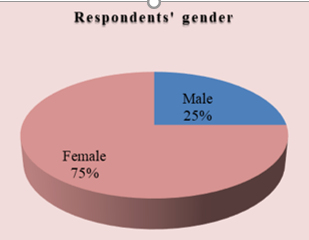
Regarding the age of the respondents, we notice that the percentage of 60% is represented by young people: 23-year-olds or younger, while the respondents in the age category between 24 and 40 year-olds are in a percentage of 20%, those between 41 and 54 years of age are 16%, those between 55 and 64 year- olds 4%, and there are no respondents at the age of 65 year-olds or older as seen in Figure 6 below. Therefore, respondents up to the age of 23 or younger occupy a significant part of the sample, which can also be explained by the availability of the students to complete questionnaires online as seen in Figure 7 below.
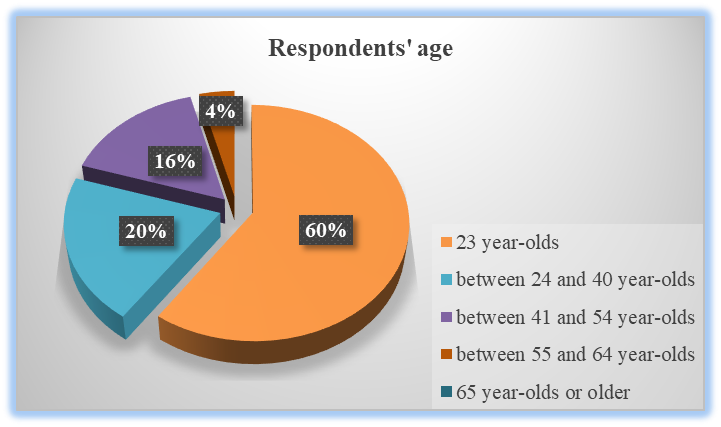
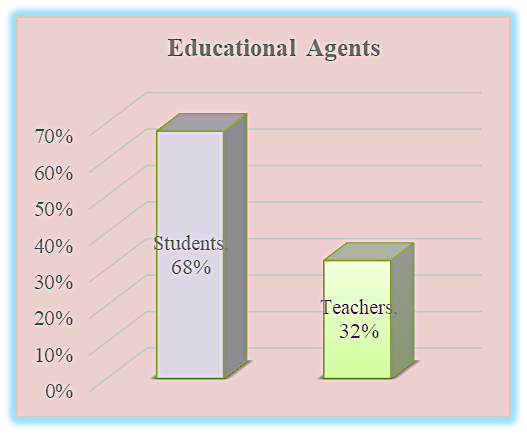
The descriptive statistics of respondents’ age, gender and educational status is presented in Table 1.
The integration of students and teachers to online communication
The process of technology adoption is largely related to communication. Glava (2020) appreciates online communication through online platforms the most concrete technological objectification of e-learning and sees online platforms as the fourth element of a virtual class besides students, teachers and curricular requirements. While Zarabanda (2019) highlights the transcendental function of school in individuals’ development and their environment, Barber (2020) considers that digital learning environments enhance individuals’ confidence, competence, and skills to manage, analyse, and filter information.
Asked if they agree to integrate in the online communication, most of the respondents chose easy and medium as seen in Figure 8 below. It can also be observed that students aged 23 or younger and teachers aged between 41 and 54 agree to integrate in the online communication, but there is also a percentage of 6% of students who integrate hard and very hard which invalidates the hypothesis. The descriptive statistics are presented in the Table 2.
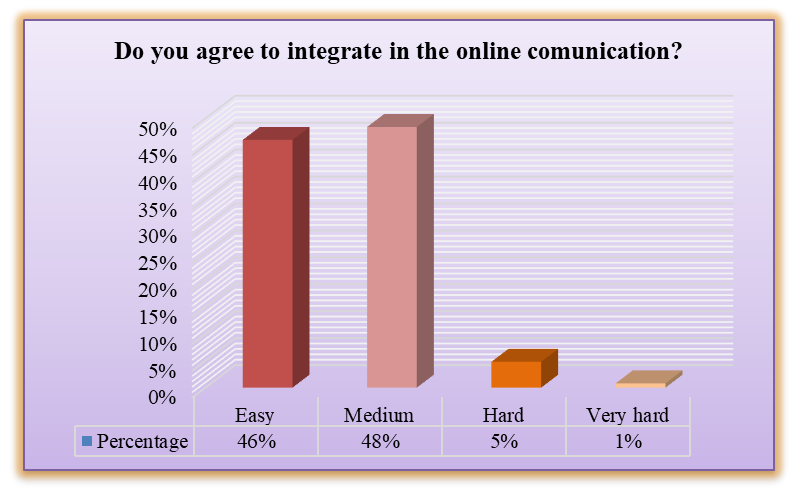
The importance to adopt digital technologies for active learning
Tuluk and Kepceoğlu (2019) sees that, through the combination of education and technology, the web pedagogical content information is increasing in the case of increasing internet usage among students.
At the scale question regarding the importance of adopting digital technologies for active learning, the respondents had the possibility to give a degree of importance from 1 to 5 (1 – completely irrelevant, 2 - not very important, 3 - medium importance, 4 - important, 5 - extremely important) to the answer options offered, and the results show an average of 4.3 confirming the hypothesis. Approaching the correlation between the criteria of integration in the online communication and the importance of adopting digital technologies, from the data included in Table 3, a small percent of 6% can be seen amongst the respondents, represented by students, who consider completely irrelevant and not so important to adopt new technologies for active learning, most of them having a hard and very hard degree of integration in the online communication.
The need for training on how to use digital technologies
Maier (2020) argues that in the education system already exists a well-defined orientation towards lifelong learning, awareness of its importance, and especially the ways to achieve it. The author claims that teachers must be among the professionals who:
- show openness and involvement in training activities,
- have confidence in the strength lifelong learning.
Adopting new technologies has an important contribution to achieve these goals. Sailin and Mahmor (2018) consider that teachers should have skills in coaching and designing meaningful learning using digital technologies so that the desired learning outcomes to be successfully achieved.
The descriptive statistics presented in Table 4 show a percentage of 61% of the respondents who need training for using digital technologies confirming the hypothesis. The appropriate values of students’ respondents between yes and no for training show the students’ trust in their ability to learn on their own to use digital technologies.
The place of accessing online platforms by educational agents
The descriptive statistics presented in Table 5 show a percentage of 94% of the respondents who access online platforms at home partially confirming the hypothesis.
Conclusion
In recent years, technological integration and the adoption of new educational technologies have allowed teaching-learning-assessment strategies applied by educational agents through experimentation with successes or failures. The need for open educational resources increases the speed of educational technologies diffusion. Teachers and students are forced to adopt new technologies without having enough information on how to use them.
The educational system must have the capacity to identify the necessary technologies, to evaluate the technological options, to integrate the new technologies in the educational process and to create a training environment about using these technologies. In other words, teachers and students, who practice this way of innovation, must have the necessary skills for the acquisition and use of new or substantially improved technologies.
The integration of teachers and students in all stages of adopting new technologies and the creating of open educational resources or improving an existing one contributes to the efficiency of open educational practices in order to offer the best solutions for enriching the formative challenges of the e-learning context. The adoption of digital technologies by students and teachers followed by the involvement in the process of designing, creating and developing open educational resources plays an important role in open educational practices.
The intersection of open educational practices with technology is crucial for the success of both the innovation process and the educational process. The high degree of technological uncertainty will lead to the allocation of more resources in the development of technology to manage uncertainty, which leads to the conclusion that the positive relationship between the performance of the education system weakens when the uncertainty about technology increases.
Adopting new technologies combined with open educational practices promotes the formation of technological skills necessary for teachers and students for the increase of creativity and critical thinking.
According to the empirical study, I have identified as new research directions the application and development of the research models from the field of technology diffusion in education in order to calculate and evaluate the rate of new technologies adoption.
References
Barber, W. (2020). Building Creative Critical Online Learning Communities through Digital Moments. The Electronic Journal of e-Learning, 18(5), 387-396. DOI:
Cucoș, C. (2020). Generarea conținuturilor școlare/suporturilor de învățare de tip elearning. Caracteristici și criterii de calitate [Generating School eLearning Contents / Supports. Characteristics and Quality Criteria]. In C. Ceobanu, C. Cucoș, O. Istrate, & I.-O. Pânișoară (Eds.), Educația digitală [Digital Education] (pp. 256-272). Polirom.
Cydis, S. (2015). Authentic instruction and technology literacy. Journal of Learning Design, 8(1), 68-78. https://eric.ed.gov/?id=EJ1060125
Glava, C. (2020). Platforme de învățare online. Premise, categorii, caracteristici esențiale [Online Learning Platforms. Premises, Categories, Essential Characteristics]. In C. Ceobanu, C. Cucoș, O. Istrate, & I.-O. Pânișoară (Eds.), Educația digitală [Digital Education] (pp. 191-200). Polirom.
Holotescu, C., & Gosseck, G. (2020). Educație deschisă. Resurse educaționale deschise și cursuri online masive deschise [Open Education. Open Educational Resources and Massive Open Online Courses]. In C. Ceobanu, C. Cucoș, O. Istrate, & I.-O. Pânișoară (Eds.), Educația digitală [Digital Education] (pp. 207-222). Polirom.
Huang, R., Spector, J. M., & Yang, J. (2019). Educational Technology. A Primer for the 21st Century. Singapore: Springer. DOI:
Ievenberg, I., Neilson, T., & Rheams, D. (2018). Research Methods for Digital Humanities. Australia: Palgrave Mcmillan. DOI:
Israte, O. (2020). Ameliorarea procesului de educație și a performanței școlare prin utilizarea instrumentelor și resurselor digitale [Improving the Educational Process and School Performance through the Use of Digital Tools and Resources]. In C. Ceobanu, C. Cucoș, O. Istrate, & I.-O. Pânișoară (Eds.), Educația digitală [Digital Education] (pp. 108-126). Polirom.
Lobonţiu, M., Big, R., Lobonţiu, G., Coteţiu, R., & Ungureanu, N. (2008). Difuzia tehnologică. De la inovare la transferul şi difuzia tehnologiei [Technological Diffusion. From Innovation to the Transfer and Diffusion of Technology]. Limes.
Maier, M. (2020). Repere în formarea continuă a cadrelor didactice din învățământul preuniversitar [Highlights in the Continuous Training of Teachers in Pre-university Education]. Buletin Științific, Fascicula Filologie, Seria A [Scientific Bulletin, Philology Fascicle, A Series], XXIX, 351-357. http://bslr.ubm.ro/files/2020/29.Maier_Monica_(351-357)_BSLR_2020.pdf
Mukoyama, T. (2003). A Theory of Technology Diffusion. Research Gate. https://www.researchgate.net/publication/23747295
Rogers, E. M. (2003). Diffusion of Innovations. New York: Free Press.
Sailin, S. N., & Mahmor, N. A. (2018). Improving Student Teachers’ Digital Pedagogy through Meaningful Learning Activities. Malaysian Journal of Learning and Instruction, 15(2), 143-173. https://eric.ed.gov/id=EJ1201692
Tuluk, G., & Kepceoğlu, İ. (2019). Pre-service teachers’ web pedagogical content knowledge and online information searching strategies. International Journal of Evaluation and Research in Education (IJERE), 18(2), 229-236.
Zarabanda, D. E. B. (2019). ICT and its purpose in the pedagogical practice. Research in Social Sciences and Technology, 4(2), 83-95. DOI:
Copyright information

This work is licensed under a Creative Commons Attribution-NonCommercial-NoDerivatives 4.0 International License.
About this article
Publication Date
23 March 2022
Article Doi
eBook ISBN
978-1-80296-955-9
Publisher
European Publisher
Volume
2
Print ISBN (optional)
-
Edition Number
1st Edition
Pages
1-803
Subjects
Education, Early Childhood Education, Digital Education, Development, Covid-19
Cite this article as:
Barkoczi, N. (2022). The Impact Of New Technologies Diffusion On Open Educational Practices. In I. Albulescu, & C. Stan (Eds.), Education, Reflection, Development - ERD 2021, vol 2. European Proceedings of Educational Sciences (pp. 412-422). European Publisher. https://doi.org/10.15405/epes.22032.41

